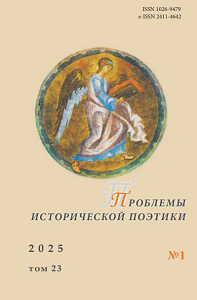Чтение сакрального текста в поздних произведениях Л. Н. Толстого
The Reading of the Sacred Text in the Later Works of Leo Tolstoy
Author(s): Nadezhda G. MikhnovetsSubject(s): Christian Theology and Religion, Studies of Literature, Russian Literature, Biblical studies
Published by: Петрозаводский государственный университет
Keywords: L. N. Tolstoy; literature; philosophy; religion; type of religiosity; sacred text; Gospel; reading; understanding; interpretation;
Summary/Abstract: The reading of the sacred text is considered in the article as a formalized action (reading the sexton in the prison church in the novel “Resurrection,”) as an event that radically changes the lives of the characters (Chuev and Pelageyushkin in the story “The Fake Coupon,”) as a process of gradual approach of the characters to higher truths (Nekhludoff in the final part of the novel “Resurrection,” Svetlogub and the old man-bespopovets in the story “Divine and Human.”) The traditional form of reading, characterized by the comprehension of the sacred word by the reader and listener, is presented in the story “Where Love Is, God Is” and in the story “The Fake Coupon.” In the first work, this type of reading is given by the pretext — the story of the pastor, Protestant Evangelist R. Silence, “Father Martin.” In the light of the hagiographic tradition, Tolstoy highlights the acceptance of evangelical truths and the spiritual upheaval in Pelageyushkin, the hero of the story “The Fake Coupon.” Due to the traditional reading mode, Tolstoy emphasized the reader (listener) from the common people. The “personal” type of reading is correlated with intermediary characters (Kieseweter, the English missionary in The Resurrection, the old man in The Resurrection and in The Divine and the Human), who refer listeners to the sacred text and interpret it in their own way. Tolstoy shows that such a preachy approach to the sacred text leads to further separation of people. Understanding of the sacred text, which transcends the temptation of a purely personal interpretation in a person, transforms not only the hero-reader himself, but also determines the possibility of a beneficial effect of the words of Scripture on others. Another variant of the “personal” type of reading is depicted in the final scene of the novel “Resurrection” and in the story “The Divine and the Human:” rational characters (Nekhludoff, Svetlogub), who had no trust in the sacred text, independently come to understand and experience it. In the process of reading, the nature of their interpretation of the sacred text is transformed (skepticism is replaced by agreement), and the difference between traditional and “personal” reading is gradually minimized.
Journal: Проблемы исторической поэтики
- Issue Year: 23/2025
- Issue No: 1
- Page Range: 207-226
- Page Count: 20
- Language: Russian

